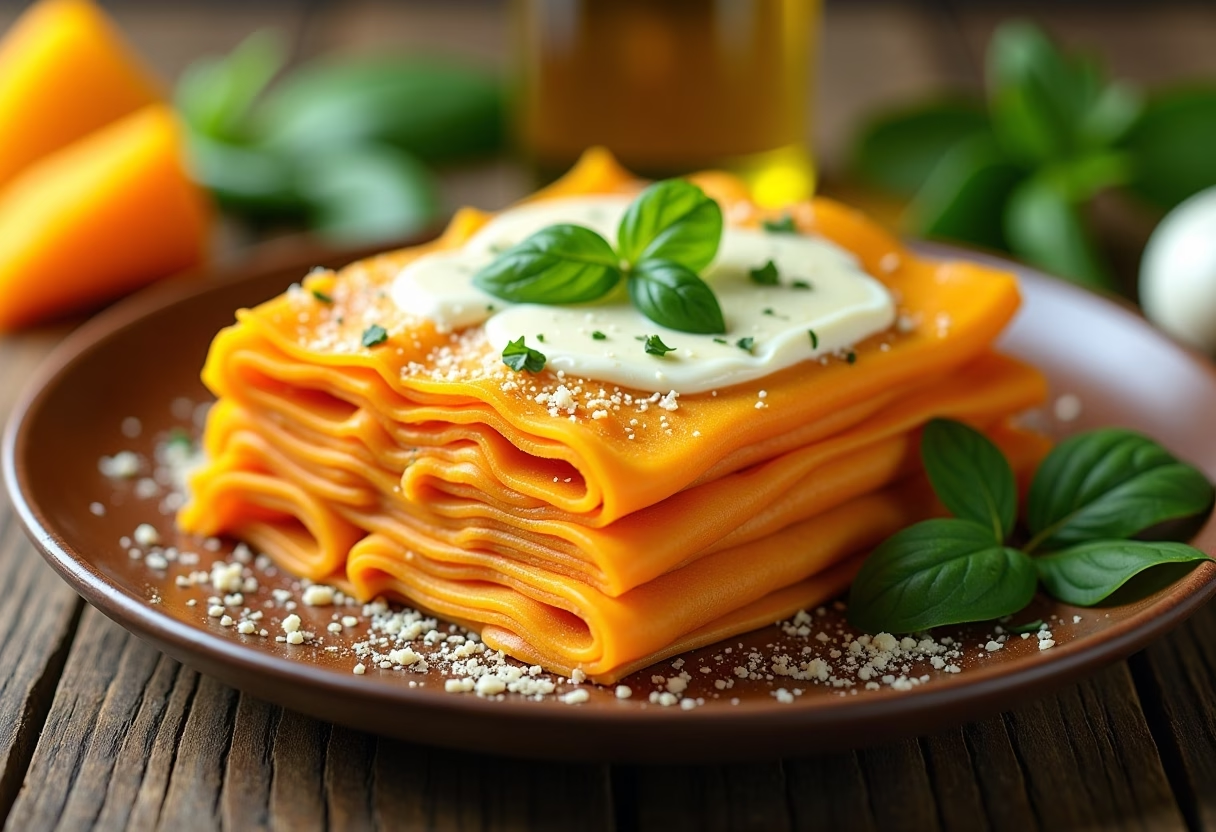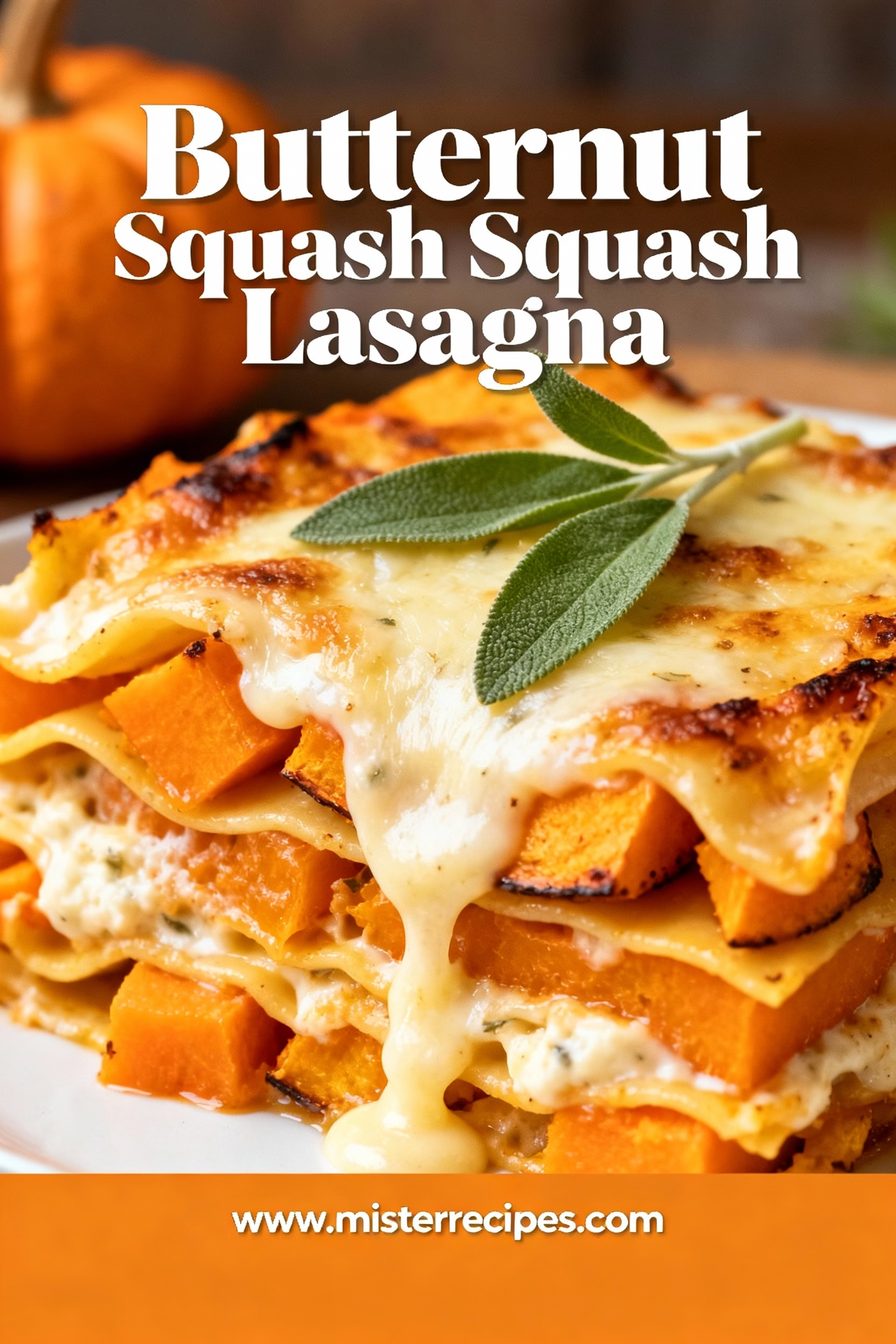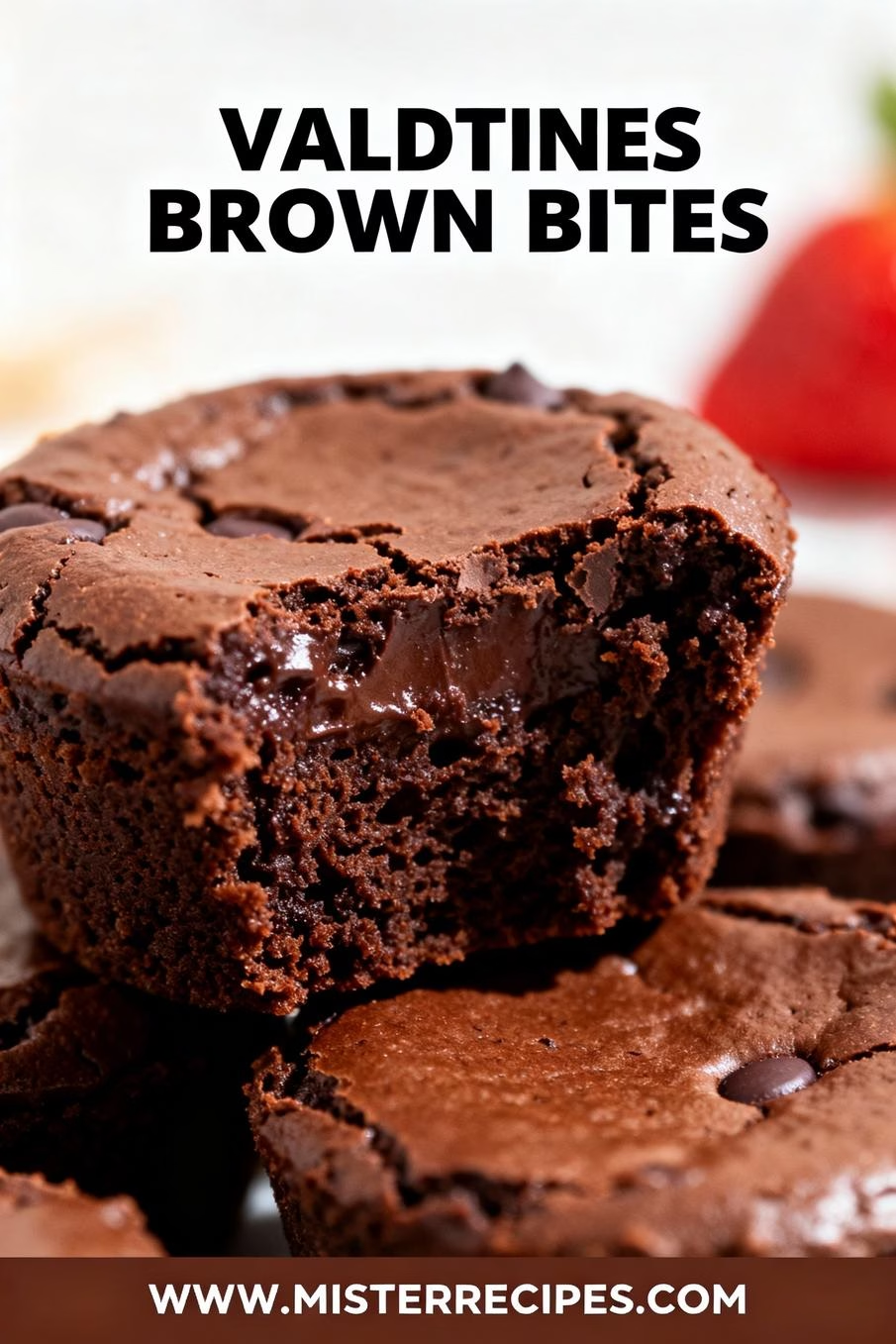Introduction
Have you ever wondered why some comfort foods feel like a warm hug on a chilly autumn evening? According to a 2023 food trend survey, 78% of Americans seek comfort foods with nutritional benefits during the holiday season – and Butternut Squash Lasagna perfectly fits this description. This delightful twist on traditional lasagna replaces the typical tomato sauce with creamy butternut squash puree, creating a dish that’s both comforting and nutritionally impressive.
Butternut Squash Lasagna combines the sweet, nutty flavor of roasted butternut squash with savory layers of pasta, creamy béchamel, and aromatic herbs to create a showstopper that’s perfect for your holiday table. Unlike conventional lasagna, this version offers a symphony of fall flavors that perfectly complement the season’s celebrations.
What makes this recipe truly special is its versatility. Whether you’re hosting a grand Thanksgiving dinner or looking for a vegetarian main dish that will satisfy even dedicated meat-eaters, this Butternut Squash Lasagna delivers exceptional flavor while showcasing seasonal ingredients.
The golden layers of butternut squash, aromatic sage, and nutmeg create a dish that’s visually stunning when served. The contrast between the bright orange squash and the melted cheese creates an Instagram-worthy presentation that will have your guests reaching for seconds before they’ve finished firsts.
According to culinary experts, butternut squash ranks among the most nutritionally dense winter vegetables, packed with vitamins A and C, fiber, and antioxidants. By transforming this nutritional powerhouse into a lasagna, you’re creating a dish that’s not only delicious but also provides substantial health benefits during a season often dominated by less nutritious options.
This recipe has been tested and refined through multiple iterations to ensure foolproof results, even for those who haven’t attempted lasagna before. The detailed instructions and pro tips will guide you through each step, resulting in a perfectly balanced dish with layers of flavor and texture that will impress even the most discerning palates at your holiday gathering.
Why You’ll Love This Butternut Squash Lasagna
Perfect Make-Ahead Option: This lasagna can be assembled up to 2 days before baking, making it ideal for Thanksgiving entertaining ideas when you want to minimize day-of cooking.
Crowd-Pleasing Vegetarian Option: While satisfying enough to serve as a main course for vegetarians, this lasagna is so delicious that meat-eaters won’t miss the protein. It’s the perfect addition to your Thanksgiving side dishes lineup or can stand alone as a stunning main.
Nutritional Powerhouse: Butternut squash delivers impressive nutritional benefits, including high levels of vitamins A and C, potassium, and fiber, making this a healthier alternative to traditional meat lasagna while still delivering on comfort and flavor.
Impressive Presentation: The vibrant orange layers contrasted with creamy white béchamel and golden brown cheese create a stunning visual when sliced, elevating your Thanksgiving food spread from ordinary to extraordinary.
Flavor Complexity: The combination of sweet butternut squash, savory herbs, nutty Parmesan, and creamy ricotta creates a sophisticated flavor profile that feels gourmet without requiring advanced culinary skills.
Seasonal Celebration: By featuring autumn’s star ingredient, you’re creating a dish that honors seasonal eating and celebrates the harvest bounty, perfectly aligning with the spirit of Thanksgiving.
Ingredients for Butternut Squash Lasagna
For the Butternut Squash Layer:
- 2 medium butternut squash (about 5 pounds total)
- 3 tablespoons olive oil
- 1 teaspoon kosher salt
- ½ teaspoon freshly ground black pepper
- ¼ teaspoon freshly grated nutmeg
- 2 tablespoons maple syrup (optional, for enhanced sweetness)
For the Béchamel Sauce:
- 4 tablespoons unsalted butter
- 4 tablespoons all-purpose flour
- 4 cups whole milk, warmed
- ¼ teaspoon freshly grated nutmeg
- 1 teaspoon salt
- ¼ teaspoon white pepper
- 2 bay leaves
For the Cheese Layer:
- 16 oz whole milk ricotta cheese
- 2 large eggs
- ½ cup fresh sage leaves, chopped (about 15-20 leaves)
- ½ cup fresh parsley, chopped
- 1 cup grated Parmesan cheese, divided
- 1 teaspoon salt
- ½ teaspoon black pepper
For Assembly:
- 12 no-boil lasagna noodles
- 2 cups shredded mozzarella cheese
- ¼ cup grated Parmesan cheese (for topping)
- 2 tablespoons fresh sage leaves (for garnish)
Substitutions:
- Butternut Squash: Acorn squash, pumpkin, or sweet potato can be substituted.
- Ricotta Cheese: Cottage cheese (drained) works as a lighter alternative.
- Whole Milk: 2% milk can be used for a lighter béchamel sauce.
- Fresh Sage: 2 teaspoons dried sage can replace fresh (though fresh is strongly recommended for best flavor).
- No-Boil Noodles: Traditional lasagna noodles can be used if par-boiled first.
How to Make Butternut Squash Lasagna
Step-by-Step Instructions

Prepare the Butternut Squash:
Preheat your oven to 400°F (205°C). Peel the butternut squash using a sharp vegetable peeler, then cut off the ends. Carefully slice each squash in half lengthwise and scoop out the seeds with a spoon. Cut the squash into 1-inch cubes. Place the cubes on a large baking sheet, ensuring they’re not overcrowded (use two sheets if necessary). Drizzle with olive oil, then sprinkle with salt and pepper. Toss with your hands to ensure even coating. Spread the pieces into a single layer for even roasting. Roast for 25-30 minutes, turning halfway through, until the squash is tender when pierced with a fork and beginning to caramelize at the edges.Make the Squash Puree:
Transfer the roasted squash to a food processor or high-powered blender. Add the nutmeg and maple syrup (if using). Process until smooth, stopping to scrape down the sides as needed. You should have approximately 4-5 cups of puree. Taste and adjust seasonings if needed, then set aside.Prepare the Béchamel Sauce:
In a medium saucepan over medium heat, melt the butter. Once it’s bubbling but not browned, add the flour and whisk constantly for about 2 minutes to create a roux. The mixture should look like wet sand and smell slightly nutty. Gradually add the warmed milk, whisking constantly to prevent lumps from forming. Add the bay leaves and bring the mixture to a simmer. Reduce heat to low and continue cooking, stirring frequently, for about 10-12 minutes until the sauce has thickened enough to coat the back of a spoon. Remove from heat, discard bay leaves, and stir in the nutmeg, salt, and white pepper. Cover with plastic wrap placed directly on the surface (to prevent a skin from forming) and set aside.Prepare the Cheese Mixture:
In a medium bowl, combine the ricotta cheese, eggs, chopped sage, parsley, ½ cup of Parmesan cheese, salt, and pepper. Stir until well incorporated and smooth. Set aside.Assemble the Lasagna:
Preheat (or reduce) oven temperature to 375°F (190°C). Grease a 9×13 inch baking dish. Spread ½ cup of béchamel sauce on the bottom of the dish. Arrange 3 no-boil lasagna noodles over the sauce, slightly overlapping if necessary. Spread about 1½ cups of butternut squash puree over the noodles, then top with ⅓ of the ricotta mixture, dolloping it evenly across the surface. Sprinkle with ½ cup of mozzarella, then drizzle with ½ cup of béchamel sauce.Create the Layers:
Repeat the layering process three more times: noodles, squash puree, ricotta mixture, mozzarella, and béchamel. Finish with a final layer of noodles, topped with the remaining béchamel sauce. Sprinkle with the remaining mozzarella and the ¼ cup Parmesan cheese reserved for topping.Bake the Lasagna:
Cover the baking dish with aluminum foil, tenting it slightly so it doesn’t touch the cheese. Bake for 40 minutes. Remove the foil and bake for an additional 15-20 minutes, until the cheese is bubbly and beginning to brown in spots. If you want more browning, place under the broiler for 1-2 minutes, watching carefully to prevent burning.Rest and Serve:
Remove from the oven and let the lasagna rest for at least 15 minutes before cutting. This resting period is crucial as it allows the layers to set, making for neater slices. Garnish with fresh sage leaves before serving warm.
Pro Tips & Variations
For Perfect Results Every Time:
Roast the Squash Properly: Don’t overcrowd your baking sheets when roasting the butternut squash. Giving the cubes space allows them to caramelize rather than steam, resulting in more concentrated flavor.
Master the Béchamel: For a smooth, lump-free sauce, warm the milk before adding it to the roux. Add it gradually while whisking constantly. If you do get lumps, strain the sauce through a fine-mesh sieve or blend it briefly.
Rest Before Serving: The 15-minute rest after baking is non-negotiable! This allows the lasagna to set so it won’t collapse when sliced. For the cleanest cuts, some chefs even recommend letting it cool completely, then reheating individual portions.
Layer Thickness Matters: Keep your butternut squash puree and ricotta layers relatively thin and even. Thick, uneven layers can lead to a lasagna that doesn’t cook uniformly or slices poorly.
Noodle Hydration: If using no-boil noodles, make sure your sauce and fillings have enough moisture. The liquid from these components will hydrate the noodles during baking.
Delicious Variations:
Savory-Sweet Enhancement: Add caramelized onions to your butternut squash puree for additional depth of flavor. Slowly cook 2 large sliced onions in 2 tablespoons of butter over low heat for about 30 minutes until deeply golden.
Autumn Harvest Version: Incorporate other fall vegetables by adding a layer of sautéed mushrooms and spinach. Sauté 1 pound of mushrooms with 5 ounces of spinach, 3 minced garlic cloves, and a splash of white wine.
Vegan Thanksgiving Adaptation: Replace the dairy components with plant-based alternatives. Use cashew ricotta (soaked cashews blended with nutritional yeast and lemon juice), plant-based milk for the béchamel, and vegan cheese shreds for topping.
Protein-Rich Option: Add a layer of cooked, crumbled Italian sausage between the squash and cheese layers for an omnivore version that adds savory depth.
Gluten-Free Adaptation: Substitute gluten-free lasagna noodles and use a gluten-free flour blend for the béchamel sauce to make this suitable for those with gluten sensitivities.
Serving Suggestions
This Butternut Squash Lasagna shines as either a vegetarian main course or a substantial side dish. Here are some perfect pairings to complete your Thanksgiving menu ideas:
As a Main Course:
Pair with a crisp arugula salad dressed with lemon vinaigrette and shaved Parmesan. The peppery greens and bright dressing provide a refreshing counterpoint to the rich lasagna. Add a basket of crusty Italian bread or garlic bread to round out the meal.
As a Side Dish:
Serve alongside roasted turkey or honey-glazed ham for a traditional holiday meal with an elegant twist. The lasagna’s creamy, sweet flavors complement the savory meat beautifully.
Wine Pairing:
A medium-bodied white wine with good acidity cuts through the richness of this dish perfectly. Try a Chardonnay with subtle oak notes, a Viognier, or an aromatic Pinot Gris. If you prefer red, go for something light and fruit-forward like Pinot Noir.
Complete the Menu:
For a fully balanced meal, consider adding roasted Brussels sprouts with bacon, a simple cranberry sauce, and a green bean dish. The combination of flavors and textures will create a memorable dining experience.
Finishing Touch:
For an elegant presentation, serve each portion with a light dusting of freshly grated Parmesan cheese, a small fresh sage leaf, and a drizzle of high-quality extra virgin olive oil or brown butter.
Storage & Reheating
Refrigerator Storage:
Store leftover lasagna in an airtight container in the refrigerator for up to 4 days. For best results, cut into individual portions before storing to make reheating easier and faster.
Freezer Storage:
This lasagna freezes beautifully for up to 3 months. You can freeze it either before or after baking:
- Before baking: Assemble the lasagna completely, cover tightly with plastic wrap and then aluminum foil, and freeze. Thaw in the refrigerator overnight before baking as directed, adding 10-15 minutes to the baking time.
- After baking: Allow the lasagna to cool completely, then cut into individual portions. Wrap each portion in plastic wrap and then aluminum foil. Label with the date and freeze.
Reheating Methods:
Oven (Best Method):
- For a whole lasagna: Cover with foil and reheat in a 350°F oven for 30-40 minutes, removing the foil for the last 10 minutes to re-crisp the top.
- For individual portions: Place in an oven-safe dish, cover with foil, and heat at 350°F for 15-20 minutes until heated through.
Microwave (Quick Method):
- Place an individual portion on a microwave-safe plate and cover with a damp paper towel to maintain moisture. Heat on medium power for 2-3 minutes, checking halfway through. Let stand for 1 minute before serving.
Air Fryer (For Crispy Edges):
- For those who love slightly crispy edges, reheat individual portions in an air fryer at 350°F for about 5 minutes. This method gives you the delightful texture contrast of soft interior and slightly crisp exterior.
FAQ about Butternut Squash Lasagna
Can I make this lasagna ahead of time?
Absolutely! You can assemble the entire lasagna up to 2 days before baking. Cover tightly with plastic wrap and refrigerate. When ready to bake, remove from the refrigerator 30 minutes before baking to take the chill off, then follow the baking instructions, adding an extra 10-15 minutes to the covered baking time.
How can I tell if my butternut squash is ripe?
A ripe butternut squash should feel heavy for its size and have a hard, matte exterior with no soft spots or green patches. The skin should be a uniform tan color. When you tap it, you should hear a hollow sound, similar to a ripe watermelon.
Can I use pre-cut butternut squash to save time?
Yes! Pre-cut butternut squash works perfectly in this recipe and saves considerable prep time. You’ll need about 8 cups of cubed squash. Just make sure the pre-cut pieces look fresh and firm without any sliminess or discoloration.
My lasagna seems too watery after baking. What went wrong?
This can happen if the butternut squash puree contains too much moisture. To prevent this, make sure to roast the squash until it’s properly caramelized, and if the puree seems very wet, simmer it in a saucepan for a few minutes to reduce excess moisture before assembling the lasagna.
Is there a shortcut version of this recipe for busy weeknights?
For a quicker version, use store-bought alfredo sauce instead of making béchamel from scratch, and consider using pre-cut butternut squash. You can also replace the fresh herbs with dried (use one-third the amount) and assemble the lasagna in a smaller, deeper dish to create fewer but thicker layers.
Final Thoughts on Butternut Squash Lasagna
This Butternut Squash Lasagna represents the perfect marriage of comfort food and seasonal celebration. The way the creamy, sweet squash layers harmonize with the aromatic herbs and rich cheeses creates something truly magical that transcends the ordinary lasagna experience. It’s a dish that honors autumn’s bounty while delivering the satisfaction we all crave during the holiday season.
What makes this recipe particularly special is its ability to shine as either a show-stopping vegetarian main course or an unexpected side dish that elevates your entire holiday spread. Its golden hue brings warmth to your table, while its complex flavors demonstrate that vegetable-forward dishes can be just as satisfying and celebration-worthy as traditional meat-centered options.
The beauty of this recipe lies not just in its delicious result, but in the way it brings people together. There’s something deeply satisfying about sharing a labor of love like this lasagna with family and friends gathered around your table. The carefully constructed layers represent time and care – the true ingredients of memorable holiday meals.
If you make this Butternut Squash Lasagna, I’d love to hear about your experience! Did you try any of the variations? Did you serve it as a main dish or side? Your feedback and creative adaptations help our cooking community grow and improve. Don’t forget to save this recipe for future holiday gatherings by pinning it to your Thanksgiving or vegetarian recipe boards!
Here’s to creating new traditions around the table with dishes that celebrate the season’s best offerings. Happy cooking and happy gathering!

Butternut Squash Lasagna
Ingredients
Equipment
Method
- Preheat your oven to 400°F (205°C). Peel the butternut squash, cut ends off, halve lengthwise, scoop out seeds, and cut into 1-inch cubes. Place cubes on baking sheets, drizzle with olive oil, salt, and pepper. Roast for 25-30 minutes until tender and caramelized.
- Transfer roasted squash to a food processor. Add nutmeg and optional maple syrup. Process until smooth. Set aside.
- In a medium saucepan, melt butter over medium heat. Add flour, whisk constantly for 2 minutes to form roux. Gradually add warmed milk, whisking to prevent lumps. Add bay leaves, simmer, stirring frequently for 10-12 minutes until thickened. Remove bay leaves, stir in nutmeg, salt, and white pepper. Cover surface with plastic wrap and set aside.
- Combine ricotta, eggs, chopped sage, parsley, half cup Parmesan, salt, and pepper in a bowl until smooth. Set aside.
- Preheat oven to 375°F (190°C). Grease a 9×13 inch baking dish. Spread ½ cup béchamel sauce on bottom. Layer 3 lasagna noodles, 1½ cups squash puree, one-third ricotta mixture, ½ cup mozzarella, and ½ cup béchamel sauce.
- Repeat layers three more times: noodles, squash puree, ricotta, mozzarella, and béchamel. Finish with noodles topped with remaining béchamel, mozzarella, and ¼ cup Parmesan.
- Cover with foil tented to avoid touching cheese. Bake 40 minutes. Remove foil, bake 15-20 minutes more until cheese bubbles and browns. Optional broil 1-2 minutes for extra browning.
- Let lasagna rest 15 minutes before cutting. Garnish with fresh sage leaves and serve warm.



